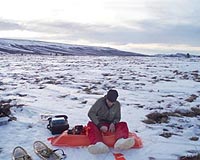| . |  |
. |
Amherst MA (SPX) Jun 12, 2009 A team of scientists from the United States, Germany, Russia and Austria returned recently from a six-month sediment drilling expedition at a frozen lake in Siberia, where they retrieved cores going back further than ever before collected in the Arctic-information they call "of absolutely unprecedented significance." Data will help scientists to understand the region's geologic climate record. Cores collected from three holes under Siberia's Lake El'gygytgyn, "Lake E" for short, are more than 30 times longer (in time) than records from the Greenland Ice Sheet, according to geoscientist Julie Brigham-Grette of the University of Massachusetts Amherst, the lead U.S. scientist. The lake was formed 3.6 million years ago when a meteor more than a half-mile in diameter hit the Earth and gouged out the 11-mile wide crater. Lake E's cores represent the longest time-continuous sediment record of past climate change in the terrestrial Arctic. The research team will compare this information with oceanic and land-based records from lower latitudes to better understand hemispheric global climate change and polar amplification. In early June, the 3.5 tons of frozen sediment cores are being flown by special cargo plane from Siberia to St. Petersburg, then on to a lab at Germany's University of Cologne for years of analysis by paleoclimatologists. Archive halves will arrive later at the University of Minnesota's LacCore facility where they'll be preserved in cold storage for future study. Brigham-Grette says the team recovered a total of 1165 feet of sediment with replicate cores to roughly 2 million years ago with as high as 98 percent recovery. Studying high-latitude climate systems and how they react to changes in the global climate system is of great importance to climate research, she points out. Of prime interest is determining why and how the Arctic climate system evolved from a warm forested ecosystem into a cold permafrost ecosystem between 2 million and 3 million years ago. "The continuous depositional record collected in this unique lake offers us a way to capture the dynamics and style of glacial/interglacial climate change when it was different in the past and why it was different," Brigham-Grette explains. "Earth's warm and cold cycles over the past 1 million years sometimes varied every 100,000 years but before that, climate change, especially in the high latitudes, varied over 41,000- and 23,000-year cycles, even before Northern Hemisphere glaciations got started 2.6 million years ago. The record from Lake E will show the ramp up to that type of change in the Earth's climate." Below these sediments, cores drilled into bedrock at the site will offer geologists a rare opportunity to study impact melt rocks and target rocks from one of the best preserved large meteor impact craters on Earth, the only one formed in silicon-rich volcanic rock. In addition, they collected sediment cores to the time of the meteor impact at 3.6 million years ago to 1033 feet below the lake floor. The lower material recovery there was due to "surprising sequences of coarse sand and gravel" interlaced with lake mud, Brigham-Grette notes. But these provide new revelations and suggest "unexpected glacial sources for these materials." Overall, impact breccia cores will be sampled at a separate lab, the International Continental Drilling Program headquarters in Potsdam, Germany. The team recovered roughly 131 feet of the earliest history of the lake in the warm middle Pliocene. This interval is fascinating, says Brigham-Grette, as a possible analog for future climate due to carbon dioxide forcing that can cause the greenhouse effect. However, initial results from the drilling are limited because sediment cores couldn't be opened in the field at such a remote site.
Share This Article With Planet Earth
Related Links University of Massachusetts Amherst Beyond the Ice Age
 Greening Arctic Not Likely To Offset Permafrost Carbon Release
Greening Arctic Not Likely To Offset Permafrost Carbon ReleaseGainesville FL (SPX) Jun 09, 2009 As the frozen soil in the Arctic thaws, bacteria will break down organic matter, releasing long-stored carbon into the warming atmosphere. At the same time, plants will proliferate, nurtured by balmier temperatures, more nutrients from decomposing soil and the increasing abundance of the greenhouse gas they depend on for growth. These connected but contrasting changes have raised a ... read more |
|
| The content herein, unless otherwise known to be public domain, are Copyright 1995-2009 - SpaceDaily. AFP and UPI Wire Stories are copyright Agence France-Presse and United Press International. ESA Portal Reports are copyright European Space Agency. All NASA sourced material is public domain. Additional copyrights may apply in whole or part to other bona fide parties. Advertising does not imply endorsement,agreement or approval of any opinions, statements or information provided by SpaceDaily on any Web page published or hosted by SpaceDaily. Privacy Statement |